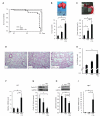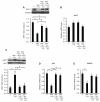β-cryptoxanthin restores nicotine-reduced lung SIRT1 to normal levels and inhibits nicotine-promoted lung tumorigenesis and emphysema in A/J mice
- PMID: 23275008
- PMCID: PMC3618609
- DOI: 10.1158/1940-6207.CAPR-12-0368
β-cryptoxanthin restores nicotine-reduced lung SIRT1 to normal levels and inhibits nicotine-promoted lung tumorigenesis and emphysema in A/J mice
Abstract
Nicotine, a large constituent of cigarette smoke, is associated with an increased risk of lung cancer, but the data supporting this relationship are inconsistent. Here, we found that nicotine treatment not only induced emphysema but also increased both lung tumor multiplicity and volume in 4-nitrosamino-1-(3-pyridyl)-1-butanone (NNK)-initiated lung cancer in A/J mice. This tumor-promoting effect of nicotine was accompanied by significant reductions in survival probability and lung Sirtuin 1 (SIRT1) expression, which has been proposed as a tumor suppressor. The decreased level of SIRT1 was associated with increased levels of AKT phosphorylation and interleukin (il)-6 mRNA but decreased tumor suppressor p53 and retinoic acid receptor (RAR)-β mRNA levels in the lungs. Using this mouse model, we then determined whether β-cryptoxanthin (BCX), a xanthophyll that is strongly associated with a reduced risk of lung cancer in several cohort studies, can inhibit nicotine-induced emphysema and lung tumorigenesis. We found that BCX supplementation at two different doses was associated with reductions of the nicotine-promoted lung tumor multiplicity and volume, as well as emphysema in mice treated with both NNK and nicotine. Moreover, BCX supplementation restored the nicotine-suppressed expression of lung SIRT1, p53, and RAR-β to that of the control group, increased survival probability, and decreased the levels of lung il-6 mRNA and phosphorylation of AKT. The present study indicates that BCX is a preventive agent against emphysema and lung cancer with SIRT1 as a potential target. In addition, our study establishes a relevant animal lung cancer model for studying tumor growth within emphysematous microenvironments.
Figures





References
-
- Yoshida T, Tuder RM. Pathobiology of cigarette smoke-induced chronic obstructive pulmonary disease. Physiol Rev. 2007;87:1047–82. - PubMed
-
- Hecht SS. Tobacco carcinogens, their biomarkers and tobacco-induced cancer. Nat Rev Cancer. 2003;3:733–44. - PubMed
-
- Benowitz NL. Clinical pharmacology of nicotine: implications for understanding, preventing, and treating tobacco addiction. Clin Pharmacol Ther. 2008;83:531–41. - PubMed
Publication types
MeSH terms
Substances
Grants and funding
LinkOut - more resources
Full Text Sources
Medical
Research Materials
Miscellaneous

